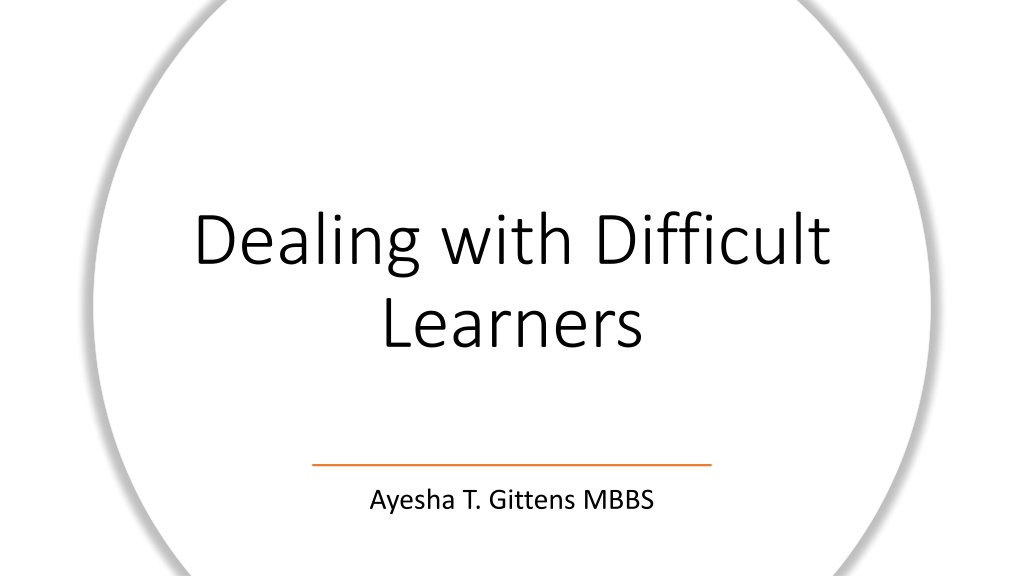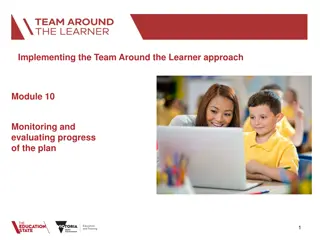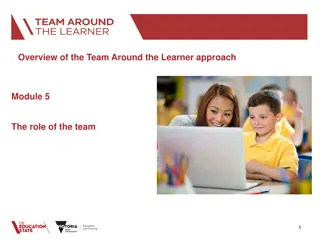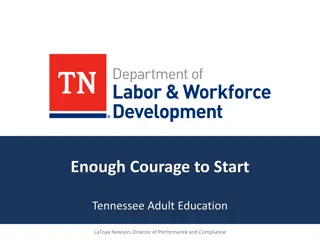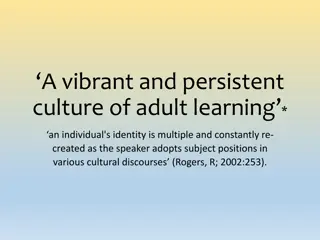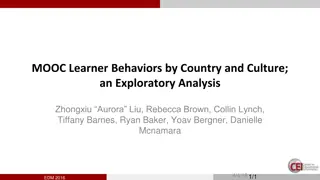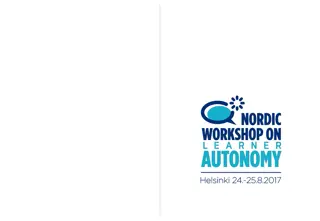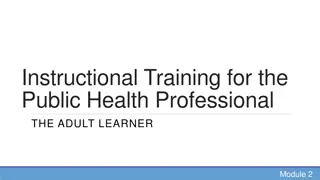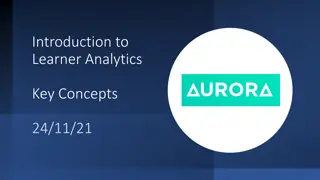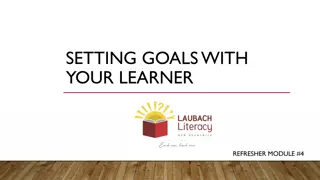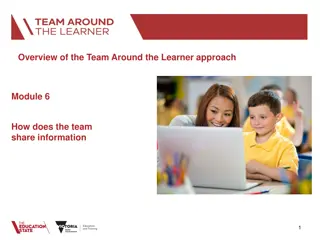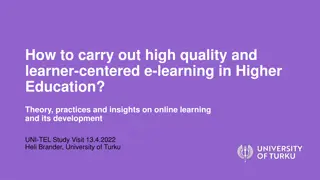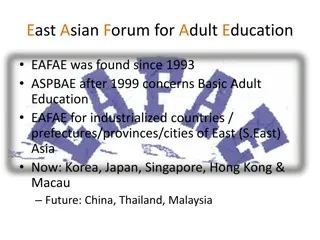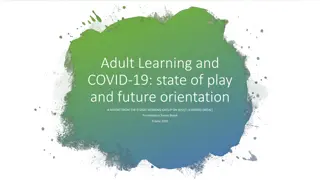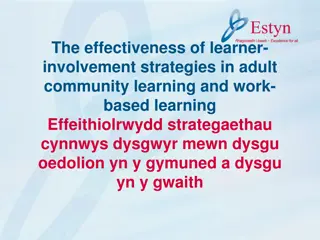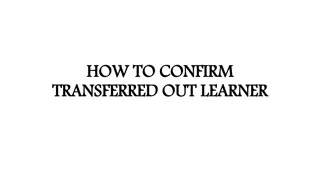Understanding and Managing Difficult Learner Behaviors in Adult Education
Dealing with difficult learners in adult education settings can impact the learning experience for all. This guide covers types of challenging behaviors, identifying underlying causes, and strategies for maintaining a constructive educational environment. By addressing disruptive behaviors effectively, educators can create a more conducive learning environment for all learners.
Download Presentation

Please find below an Image/Link to download the presentation.
The content on the website is provided AS IS for your information and personal use only. It may not be sold, licensed, or shared on other websites without obtaining consent from the author. Download presentation by click this link. If you encounter any issues during the download, it is possible that the publisher has removed the file from their server.
E N D
Presentation Transcript
Dealing with Difficult Learners Ayesha T. Gittens MBBS
It only takes one learner demonstrating difficult behavior to affect the educational experience of all of the learners present Introduction
Objectives Describe types of challenging learner behaviors Determine the underlying cause of challenging learner behaviors Approach to the difficult learner Demonstrate how to maintain the educational alliance with the difficult learner & give effective feedback to the difficult learner
Behavior on the part of the learner that obstructs learning in an adult education setting. What is disruptive behavior? Two aspects to describing this behavior: 1. The type of behavior 2. The degree of disruptiveness
Types of difficult learner behaviors 1. Withdrawal and failure to engage 2. Monopolization of conversation 3. Disruption with frequent interruptions or side conversations 4. Argumentative interjections
Degree of disruptiveness Three degrees of behavior disruptiveness: 1. Being inattentive- Not intending to disrupt the teacher or peers Difficulty focusing on the learning task 2. Acting out- Intending to disrupt the teacher or peers Breaking rules and offending others 3. Threatening/ harmful/violent behavior This is the suggestion or intention to perform physical or psychological harm to another learner, an instructor or classroom property
Different underlying issues can drive the same outward behavior Identifying the underlying etiology Only when the underlying issue is addressed can an appropriate and targeted plan for improvement be cocreated with the learner
Identifying the underlying etiology There are many causes of disruptive behaviors among adult learners: Neurological and psychosocial Learner stressors Variables within the learner environment
Underlying etiology: Neurological, Psychosocial & Medical Reasons Inadequately treated or undiagnosed medical conditions can manifest in the classroom setting as disruptive behavior. This can include substance use disorders or other neuropsychological conditions
Underlying etiology: Learner stressors Examples: Student plus caregiver Student plus full or part time job Student plus heavy research obligation
Underlying etiology: Variables in the learning environment Inadequately planned learning activities and environments can result in disruptive learner behaviors. It is important for clear goals and objectives to be identified and the relevance of the topic to be made clear. Unclear goals, objectives and relevance can result in increased frustration, anxiety and resentment of learners.
Two- part approach 1. In the learning environment at the time of the disruptive behavior Approach to the difficult learner 2. After the session - addressing the learner and identifying the underlying etiology of the behavior
Techniques: Approach to the difficult learner 1. SOAP 2. Advocacy-inquiry
SOAP Subjective, Objective, Assessment, Plan SOAP technique Adapted from patient- care models Allows you to gather basic data, make an objective assessment and then develop a plan of action to address the difficult learner- teacher interaction
SOAP: SUBJECTIVE This involves creating a differential diagnosis of the learner in difficulty. ASK: What was it that made you think there may be a problem? What do others think of the learner s behavior or performance? Is there a pattern of behavior that exists? Is the learner aware that a problem exists?
SOAP: SUBJECTIVE CONSIDER: The behaviors displayed may just be a symptom of an underlying issue. It is important to gather wide perspectives Learners may already be aware of their problem and may be working to remedy it. A learner s lack of awareness of an issue may be an indication of a more significant underlying problem.
SOAP: OBJECTIVE This is an objective description of the specific instances of problematic behaviors ASK What are the specific behaviors that are observed? When did they occur?
SOAP: OBJECTIVE CONSIDER Write down specific instances of problematic behaviors in detail. These detailed documentations should be shared with the learner and will help to assess the nature of the problem as well as in deciding on the necessary interventions.
SOAP: ASSESSMENT This involves making the link between the manifested behavior and the underlying etiology of this behavior It may be a joint assessment made after a discussion between the educator and the learner as to why the behavior occurred ASK: What are the possible underlying issues?
SOAP: PLAN Involves discussion with the learner to seek an agreed upon plan to avoid a similar situation again in the future ASK: Do you need to gather more data? Have you provided detailed behavior- specific feedback? Is the learner aware of his/her disruptive behaviors? Is the aware learner already seeking help to remedy their problem? Does the unaware learner have a more significant issue that needs to be identified before a solution can be found? Do you need to get assistance from the school or other support?
SOAP: PLAN Plan CONSIDER: Intervention Detailed, specific feedback is the cornerstone of straightforward difficult learner situations Share detailed observations with the learner to recommend specific changes Set a time to reassess the learner s performance An unsuccessful intervention may represent a larger problem that requires external help Getting help This should not be a last resort Utilize the resources of the program and the school to help learners in need Preceptor issues Not all difficult learner issues are related to the learner An un-anticipated personality clash can prevent the establishment of a close working relationship necessary for effective teaching
Adapted from simulation- debriefing literature Advocacy- inquiry technique Allows the learner to explain, analyze and synthesize information and emotional states Facilitates an improvement in the learner s performance in future similar situations
Advocacy- inquiry technique Steps involved include: processing reactions analyzing the situation generalizing to everyday experiences shaping future actions by lessons learned
Advocacy- inquiry technique 3 components to this model: 1. Reflective practice 2. Debriefing stance 3. A way of talking advocacy & inquiry
Advocacy- inquiry technique: Component #1 Reflective practice Allows learner to scrutinize his/ her own behavior Learners are able to self-correct and improve their behaviors Those who are unable to self- scrutinize tend to maintain ineffective habits and behaviors
Advocacy- inquiry technique: Component #2 Debriefing stance This involves moving away from the judgmental and non-judgmental approaches to debriefing with good judgement approach . .
The judgmental approach Often involves harsh criticism and a judgmental tone Presumes an essential failure in the thinking or actions of the trainee Can cause humiliation, dampened motivation and a future reluctance to raise questions in the future.
The non-judgmental approach Aims to to deliver a critical message while avoiding negative emotions and defensiveness Aims to maintain the learner s trust. Examples of this include: Sandwich approach, where a compliment is followed by a criticism and then another compliment Socratic approach- in which leading questions are asked in a tone of voice that is used to guide the trainee to the critical insight
Debreifing with good judgement approach Values the expert opinion of the instructors, while at the same time valuing the unique perspective of each trainee. Uses Advocacy and Inquiry Advocacy an assertion, observation or statement observed by the instructor Inquiry- how the instructor tests his/ her hypothesis
Advocacy- inquiry technique: Component #3 One standard approach : 1. 2. 3. Use of advocacy- inquiry to discover what produced the results Instructor notices a relevant behavior Instructor observes what actions seemed to lead to this behavior
It only takes one learner demonstrating difficult behavior to affect the educational experience of all the learners present Consider that there may be several underlying causal factors that need to be addressed simultaneously or consecutively. Addressing disruptive behavior without forethought can provoke escalation of the disruptive behavior Standardized techniques can help instructors to address disruptive behavior Conclusion
References 1.Chen, H.C., et al., The Health Professions Education Pathway: Preparing Students, Residents, and Fellows to Become Future Educators. Teach Learn Med, 2017. 29(2): p. 216-227. 2. Dobmeier, R. and J. Moran, Dealing with disruptive behavior of adult learners. New Horizons in Adult Education and Human Resource Development, 2008. 22(2): p. 29-54. 3. Hendricson, W.D. and J.H. Kleffner, Assessing and helping challenging students: Part One, Why do some students have difficulty learning? J Dent Educ, 2002. 66(1): p. 43-61. 4. Hicks, P.J., et al., To the point: medical education reviews--dealing with student difficulties in the clinical setting. Am J Obstet Gynecol, 2005. 193(6): p. 1915-22. 5. Langlois, J.P. and S. Thach, Managing the difficult learning situation. Fam Med, 2000. 32(5): p. 307-9. 6. Langlois, J.P. and S. Thach, Preventing the difficult learning situation. Fam Med, 2000. 32(4): p. 232-4. 7. McKeon, B.A., et al., A Consensus Guideline to Support Resident-as-Teacher Programs and Enhance the Culture of Teaching and Learning. Journal of Graduate Medical Education, 2019. 11(3): p. 313-318. 8. Rudolph, J.W., et al., Debriefing with good judgment: combining rigorous feedback with genuine inquiry. Anesthesiol Clin, 2007. 25(2): p. 361-76. 9. Samuel, A. and A. Konopasky, Creating supportive learning environments: The role of the medical educator. Clin Teach, 2021. 10. Schnapp, B.H., et al., An Interactive Session to Help Faculty Manage Difficult Learner Behaviors in the Didactic Setting. MedEdPORTAL, 2018. 14: p. 10774. 11. Seven Rules of handling Difficult Students. Available from: https://www.smartclassroommanagement.com/2011/04/23/7-rules-of-handling-difficult- students/.
